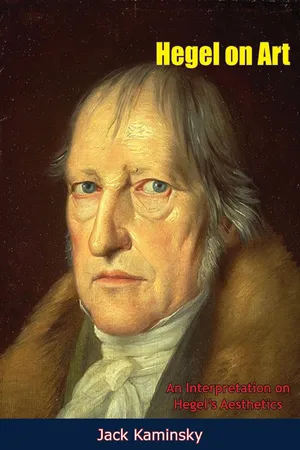
- 176 pages
- English
- ePUB (mobile friendly)
- Available on iOS & Android
eBook - ePub
About this book
Professor Kaminsky's lucid exposition is, surprisingly, the first attempt in English to deal extensively and critically with Hegel's views on art, as outlined in his difficult volumes on that subject. Hegel on Art thus performs a needed service for those interested in either the philosophy or the history of the fine arts.
Hegel's idealistic metaphysics was the last European endeavor to construct a universal philosophical system on the traditional pattern, and to modern readers it can easily appear more imposing than useful. But in his examination of art, according to Professor Kaminsky, the German philosopher became "the most empirical of the empiricists," and his observations can be valuable to us quite independent of our commitment to his metaphysics.
Moreover, as Professor Kaminsky shows, Hegel's metaphysical framework does give him an advantage not available under the rigorous skepticism of today's positivist or symbolist: he can recognize that art mirrors the world of action, and so can provide it with objective validity. As the author concludes in Hegel's defense: "It may well be that only art can be used to communicate the important episodes that happen to us or others....Without art, we lose one of our great sources of information as to who we are and what we ought to do."
"[Kaminsky] succeeds in the difficult task of summarizing Hegel's aesthetics in a clear, well-balanced text which follows the historical lines set down by the philosopher. His work is the most extensive study of the subject available in English."—Library Journal
Hegel's idealistic metaphysics was the last European endeavor to construct a universal philosophical system on the traditional pattern, and to modern readers it can easily appear more imposing than useful. But in his examination of art, according to Professor Kaminsky, the German philosopher became "the most empirical of the empiricists," and his observations can be valuable to us quite independent of our commitment to his metaphysics.
Moreover, as Professor Kaminsky shows, Hegel's metaphysical framework does give him an advantage not available under the rigorous skepticism of today's positivist or symbolist: he can recognize that art mirrors the world of action, and so can provide it with objective validity. As the author concludes in Hegel's defense: "It may well be that only art can be used to communicate the important episodes that happen to us or others....Without art, we lose one of our great sources of information as to who we are and what we ought to do."
"[Kaminsky] succeeds in the difficult task of summarizing Hegel's aesthetics in a clear, well-balanced text which follows the historical lines set down by the philosopher. His work is the most extensive study of the subject available in English."—Library Journal
Frequently asked questions
Yes, you can cancel anytime from the Subscription tab in your account settings on the Perlego website. Your subscription will stay active until the end of your current billing period. Learn how to cancel your subscription.
No, books cannot be downloaded as external files, such as PDFs, for use outside of Perlego. However, you can download books within the Perlego app for offline reading on mobile or tablet. Learn more here.
Perlego offers two plans: Essential and Complete
- Essential is ideal for learners and professionals who enjoy exploring a wide range of subjects. Access the Essential Library with 800,000+ trusted titles and best-sellers across business, personal growth, and the humanities. Includes unlimited reading time and Standard Read Aloud voice.
- Complete: Perfect for advanced learners and researchers needing full, unrestricted access. Unlock 1.4M+ books across hundreds of subjects, including academic and specialized titles. The Complete Plan also includes advanced features like Premium Read Aloud and Research Assistant.
We are an online textbook subscription service, where you can get access to an entire online library for less than the price of a single book per month. With over 1 million books across 1000+ topics, we’ve got you covered! Learn more here.
Look out for the read-aloud symbol on your next book to see if you can listen to it. The read-aloud tool reads text aloud for you, highlighting the text as it is being read. You can pause it, speed it up and slow it down. Learn more here.
Yes! You can use the Perlego app on both iOS or Android devices to read anytime, anywhere — even offline. Perfect for commutes or when you’re on the go.
Please note we cannot support devices running on iOS 13 and Android 7 or earlier. Learn more about using the app.
Please note we cannot support devices running on iOS 13 and Android 7 or earlier. Learn more about using the app.
Yes, you can access Hegel on Art by Jack Kaminsky in PDF and/or ePUB format, as well as other popular books in Art & Art General. We have over one million books available in our catalogue for you to explore.
Information
Topic
ArtSubtopic
Art GeneralREQUEST FROM THE PUBLISHER

Thank you so much for reading our book, we hope you really enjoyed it.
As you probably know, many people look at the reviews before they decide to purchase a book.
If you liked the book, could you please take a minute to leave a review with your feedback?
60 seconds is all I’m asking for, and it would mean the world to us.
Thank you so much,
Papamoa Press
{1} Hegel’s Phenomenology of Mind should also be mentioned, although it does not contain the close-knit inquiry into the nature of thought that appears in the logical treatises, especially the Science of Logic.
{2} J. M. E. McTaggart pointed out that Kant was not really even permitted to say that the thing-in-itself is. This is a judgment, “and a judgment involves categories, and we are thus forced to surrender the idea that we can be aware of the existence of anything which is not subject to the laws governing experience” (Studies in the Hegelian Dialectic [2d ed.; Cambridge: Cambridge University Press, 1922], p. 27). Nor does Paton answer this objection to Kant by maintaining that the noumena are the “condition” of the appearance of phenomena. How can the noumena be the condition of the appearance of phenomena without implying that there is a causal connection between noumena and phenomena? See H. J. Paton, Kant’s Metaphysic of Experience (London: George Allen and Unwin, 1936), I, 62.
{3} Critique of Pure Reason, translated by F. Max Muller (2d ed., rev.; New York: Macmillan Co., 1934), pp. 66 ff.
{4} The nature of these derivations was not clearly presented by Kant, and in most instances the derivations were arbitrary. See N. K. Smith, A Commentary on Kant’s Critique of Pure Reason (London: Macmillan Co., 1918), pp. 194 ff.
{5} SW, Lasson, IV, 253. See also Science of Logic, translated by Johnston and Struthers (New York: Macmillan Co., 1929), II, 247.
{6} SW, Lasson, V, 69; Encyclopedical Logic, translated by Wallace (2d ed., rev.; Oxford: Clarendon Press, 1892), p. 88.
{7} Generally, Kant’s views seemed to invalidate the possibility of any such deduction. If the categories were derived from some ge...
Table of contents
- Title page
- TABLE OF CONTENTS
- DEDICATION
- INTRODUCTION
- I. THE IDEA
- II. THE IDEA IN ART
- III. THE SYMBOLIC STAGE OF ART: ARCHITECTURE
- IV. THE CLASSICAL STAGE OF ART: SCULPTURE
- V. THE ROMANTIC STAGE OF ART
- VI. THE ROMANTIC STAGE OF ART: PAINTING
- VII. THE ROMANTIC STAGE OF ART: MUSIC
- VIII. THE ROMANTIC STAGE OF ART: POETRY
- IX. CONCLUSION AND CRITICISM
- NOTES-ABBREVIATIONS
- REQUEST FROM THE PUBLISHER